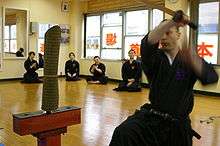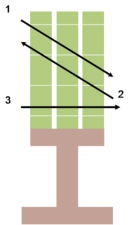Tameshigiri

Tameshigiri (試し斬り, 試し切り, 試斬, 試切) is the Japanese art of target test cutting. The kanji literally mean "test cut" (kun'yomi: ためし ぎり tameshi giri). This practice was popularized in the Edo period (17th century) for testing the quality of Japanese swords.[1] It continues to the present day, but has evolved into a martial art which focuses on demonstrating the practitioner's skill with a sword.
Origins
During the Edo period, only the most skilled swordsmen were chosen to test swords, so that the swordsman's skill was not a variable in determining how well the sword cut. The materials used to test swords varied greatly. Some substances were wara (rice straw), goza (the top layer of tatami mats), bamboo, and thin steel sheets.
In addition, there were a wide variety of cuts used on cadavers and occasionally convicted criminals,[2] from tabi-gata (ankle cut) to O-kesa (diagonal cut from shoulder to opposite hip). The names of the types of cuts on cadavers show exactly where on the body the cut was made. Older swords can still be found today that have inscriptions on their nakago (tang) that say things such as, "5 bodies with Ryu Guruma (hip cut)". Such an inscription, known as a tameshi-mei or saidan-mei (cutting signature) would add greatly to a sword's value,[3] compensating the owner somewhat for the large sums of money typically charged for the test.[4]
Aside from specific cuts made on cadavers, there were the normal cuts of Japanese swordsmanship, i.e. downward diagonal (Kesa-giri), upward diagonal (Kiri-age or Gyaku-kesa), horizontal (Yoko or Tsuihei), and straight downward (Jodan-giri, Happonme, Makko-giri, Shinchoku-giri or Dottan-giri).
There is an apocryphal story of a condemned criminal who, after being told he was to be executed by a sword tester using a Kesa-giri cut, calmly joked that if he had known that was going to happen, he would have swallowed large stones to damage the blade.[3]
Today

In modern times, the practice of tameshigiri has come to focus on testing the swordsman's abilities, rather than the sword's. Indeed, the swords used are typically inexpensive ones.[5]
Practitioners of tameshigiri sometimes use the terms Shito (試刀, sword testing) and Shizan (試斬, test cutting, an alternate pronunciation of the characters for tameshigiri) to distinguish between the historical practice of testing swords and the contemporary practice of testing one's cutting ability. The target most often used is the tatami "omote" rush mat. To be able to cut consecutive times on one target, or to cut multiple targets while moving, requires that one be a very skilled swordsman.
Targets today are typically made from goza, or rolled tatami omote, the top layer of the traditional Japanese floor covering, either bundled or rolled into a cylindrical shape. They may be soaked in water to add density to the material. This density is to approximate that of flesh. Green bamboo is used to approximate bone.
Once the goza target is in this cylindrical shape, it has a vertical grain pattern when stood vertically on a target stand, or horizontally when placed on a horizontal target stand (dotton or dodan). This direction of the grain affects the difficulty of the cut.
The difficulty of cuts is a combination of the target material hardness, the direction of the grain of the target (if any), the quality of the sword, the angle of the blade (hasuji) on impact, and the angle of the swing of the sword (tachisuji).
When cutting a straw target that is standing vertically, the easiest cut is the downward diagonal. This is due to a combination of the angle of impact of the cut against the grain (approximately 30-50 degrees from the surface), the downward diagonal angle of the swing, and the ability to use many of the major muscle groups and rotation of the body to aid in the cut.
Next in difficulty is the upward diagonal cut which has the same angle, but works against gravity and uses slightly different muscles and rotation. The third in difficulty is the straight downward cut, not in terms of the grain but in terms of the group of muscles involved. The most difficult cut of these four basic cuts is the horizontal direction (against a vertical target) which is directly perpendicular to the grain of the target.
There are a number of swordsmen who have recently set records in the field of tameshigiri. Mitsuhiro Saruta, founder of Ryuseiken, set the initial Guinness World Record for completing 1000 cuts (senbongiri) in 1 hour 36 minutes on September 20, 1998.[6] In 2000, Russell McCartney of Ishiyama-ryū completed 1181 consecutive cuts without a missed attempt in 1 hour 25 minutes.[7] Both Saruta and McCartney performed senbongiri using a kata-based approach as one of the criteria for their challenge.[8] Isao Machii of Shūshinryū currently has the record for the fastest senbongiri performance of 36 minutes.[9] Machii also holds records for the most cuts in three minutes (252), and the most cuts to a single free-standing target (7).[10][11] The record for most cuts in one minute (68) is held by Daitō-ryū Aiki-jūjutsu practitioner Konstantinos Karipidis of Greece.[12] Toshishiro Obata holds the record for Kabuto Wari, or helmet cutting, for his cut on a steel Kabuto (helmet).[13] Obata also holds the Ioriken Battojutsu speed cutting record for 10 cuts on 10 targets over three rounds. His times are 6.4, 6.4, and 6.7 seconds respectively. Brandt Noel of San Yama Ryu Bujutsu holds the record of 19 mats with Katana using Kesa-giri.
Historical European Martial Arts reconstructors, under the term "test cutting", engage in similar exercises with various European swords. While tatami omote, green bamboo (though rarely), and especially meat are the preferred cutting targets, other substances are commonly used due to being cheaper, and much easier to obtain: pool noodles, various gourds (pumpkins, squash, etc.), water-filled plastic bottles, soaked newspaper rolls, synthetic targets or wet clay.
Target configurations

The targets can be placed in different configurations:
- Most frequently, there is a single stand on which a single target is placed vertically.
- A second configuration involves multiple targets in place vertically on a long stand (a yoko-narabi).
- A third configuration involves multiple targets placed horizontally on a different type of stand called a dodan or dotton.
- A fourth configuration involves single (#1) or multiple targets (#2), each on separate stands.
- A fifth configuration(particular to rolled goza) involves multiple targets rolled together to create a thicker and denser target. This can be used in the previous configurations (#1, #2, #3)
References
- ↑ Kapp (1987), p.41
- ↑ Sesko (2011), p.148
- 1 2 Man, John (10 February 2011). Samurai. Transworld. p. 55. ISBN 978-1-4090-1105-7.
- ↑ Sesko (2011), p.149
- ↑ Kapp (1987), p.42
- ↑ International Batto-do Shizan Association
- ↑ Wong, Brad (6 July 2007). "Seattle samurai marksman holds world record". Seattle Post-Intelligencer. Seattle.
- ↑ McCartney, Russell (2000). "Senbongiri". Seattle, WA.
- ↑ Guinness World Records Website: Fastest Time to Complete 1,000 Cuts
- ↑ Guinness World Records Website: Most Cuts In 3 Minutes
- ↑ Guinness World Records Website: Most Cuts to One Mat
- ↑ Guinness World Records Website: Most Cuts In One Minute
- ↑ Kabuto Wari Record
- Bibliography
- Sesko, Markus (2011). Legends and Stories around the Japanese Sword. BoD – Books on Demand. ISBN 978-3-8423-6603-9.
- Kapp, Leon (1987). The Craft of the Japanese Sword. Kodansha International. ISBN 978-0-87011-798-5.
- Obata, Toshishiro. "Shinkendo Tameshigiri: Samurai Swordsmanship & Test-Cutting". Los Angeles, CA: ISF Publishing, 2005. ISBN 978-0-9668677-5-6
- Obata, Toshishiro. Crimson Steel. Essex, UK: Dragon Books, 1987. ISBN 978-0-946062-19-5
- Obata, Toshishiro. Naked Blade. Essex, UK: Dragon Books, 1985. ISBN 978-0-946062-18-8